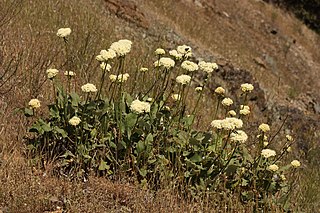
Eriogonum is a genus of flowering plants in the family Polygonaceae. The genus is found in North America and is known as wild buckwheat. This is a highly species-rich genus, and indications are that active speciation is continuing. It includes some common wildflowers such as the California buckwheat.
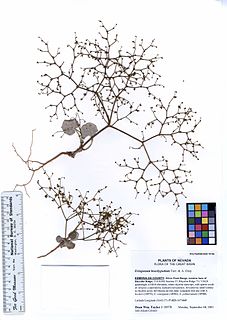
Eriogonum brachypodum is a species of wild buckwheat known by the common name Parry's buckwheat. This annual herb is native to the southwestern United States from California to Utah and especially the Mojave Desert. It grows in sandy and gravelly substrates. It has a skeletonlike spindly stem which branches many times. It can grow 5 to 50 centimeters in height and up to a meter in width. There is an array of rounded, dark-colored leaves around the base. Leaves are a few centimeters long and fuzzy on the undersides. Most of the plant is actually the spreading inflorescence. At intervals on the otherwise naked branches hang tiny clusters of glandular flowers a few millimeters wide in involucres of bell-shaped bracts. Each flower is less than three millimeters wide.
Eriogonum dasyanthemum is a species of wild buckwheat known by the common name chaparral buckwheat. This plant is endemic to California where it is limited to the Northern Coast Ranges, but it is quite common in its native range.
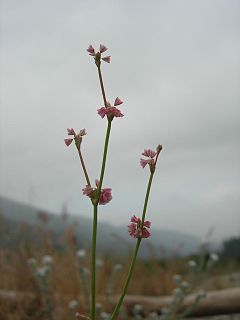
Eriogonum davidsonii is a species of wild buckwheat known by the common name Davidson's buckwheat. This plant is native to the southwestern United States and northern Baja California. It grows in sandy or gravelly soils, mixed grassland, saltbush, chaparral, sagebrush communities as well as oak and montane conifer woodland. It is a spindly annual herb growing up to 40 centimeters in height. Leaves are fuzzy, basal, and round with wavy or wrinkly margins fuzzy. They are two centimeters wide. The plant is variable in appearance, but is usually erect with thin, naked, neatly branching stems bearing clusters of tiny flowers at widely spaced nodes. Each flower is about 2 millimeters wide, bell-shaped, and can be white, pink or red. Flowering occurs May to September.

Eriogonum deflexum is a species of wild buckwheat known by the common names flatcrown buckwheat, flat-top buckwheat, and skeletonweed. This plant is native to the southwestern United States and northwestern Mexico, where it is common and grows in a variety of habitats, especially desert scrub. It is somewhat weedy where it is most abundant. This is an annual which varies in size from small patches on the ground to tangled bushes approaching two meters in height; it may be dense or thin and spindly. This is a brown or greenish weedy-looking herb with a many-branched stem. The leaves are located at the base of the plant and are rounded and woolly and one to four centimeters long. Small clusters of flowers appear at intervals along the branches with each flower only one to three millimeters wide and white or pinkish in color.
Eriogonum gilmanii is a species of wild buckwheat known by the common name Gilman's buckwheat. This plant is endemic to Inyo County, California, where it is known only from the desert mountain slopes of the Cottonwood, Last Chance, and Panamint Ranges. This is a flat mat-forming, woody perennial herb which grows in patches under 20 centimeters wide on rocky soils. Its tiny fleshy leaves, each under half a centimeter wide, are covered in a dense hairy white wool. The plant blooms in showy erect heads of small, inflated flowers, each a few millimeters wide and yellowish or orange with red stripes.
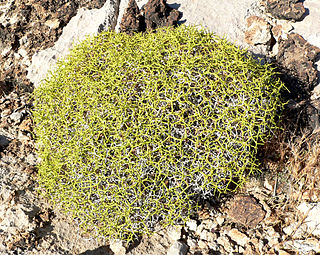
Eriogonum heermannii is a species of wild buckwheat known by the common name Heermann's buckwheat. It is native to the southwestern United States from California to Utah where it grows on rocky slopes, desert flats, and dry washes.
Eriogonum intrafractum is a species of wild buckwheat known by the common names jointed buckwheat and napkinring. This plant is endemic to Inyo County, California, where it is known only from the mountain ranges surrounding Death Valley. It is an uncommon, distinctive perennial herb which grows in scattered patches on rocky limestone soils in these desert mountains.
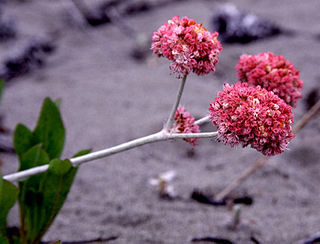
Eriogonum latifolium is a species of wild buckwheat known by the common names seaside buckwheat and coast buckwheat. This plant is native to the coastline of the western United States from Washington to central California, where it is a common resident of coastal bluffs and scrub.

Eriogonum maculatum is a species of wild buckwheat known by the common name spotted buckwheat. It is native to western North America from Washington to Baja California to Utah, where it can be found in a number of habitats, often in abundance.

Eriogonum nidularium is a species of wild buckwheat known by the common name birdnest buckwheat. It is native to the sandy flats and desert dry washes of the Mojave Desert and Great Basin in the western United States, where it is common and abundant. This is a distinctive annual herb producing a thin, multibranched stem which curves in on itself to form a rounded, tangled mass.

Eriogonum plumatella is a species of wild buckwheat known by the common name yucca buckwheat. It is native to the desert southwest of the United States.

Eriogonum saxatile is a species of wild buckwheat known by the common name hoary buckwheat. It is native to the dry, rocky mountain slopes of California and Nevada, where it is a common plant.

Trillium pusillum is a species of flowering plant in the family Melanthiaceae known by the common names dwarf trillium, least trillium and dwarf wakerobin. It is native to the southeastern and south-central United States from Oklahoma to Maryland.
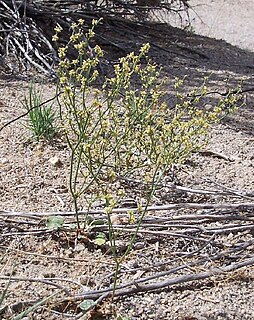
Eriogonum ampullaceum is a species of wild buckwheat known by the common name Mono buckwheat.

Eriogonum brachyanthum is a species of wild buckwheat that is commonly known as shortflower buckwheat. It is native to eastern California and western Nevada, particularly the Mojave Desert region, where it is common to abundant, and even sometimes weedy. It is also known from southern Oregon. The plant grows in sandy habitats such as desert flats and sagebrush. It also grows in pinyon-juniper and montane conifer woodlands. It is an annual herb that grows 30 to 40 centimeters tall. Leaves are located at the base of the stem, woolly, and oval or rounded in shape. The top of the stem is occupied by a branching inflorescence bearing many widely spaced clusters of flowers. Each individual flower is about a millimeter wide and light yellow in color. Flowers bloom from April to November.
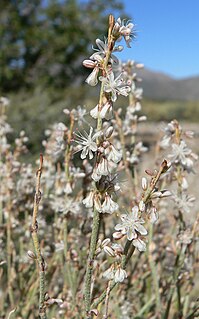
Eriogonum panamintense is a species of wild buckwheat known by the common name Panamint Mountain buckwheat. It is native to several of the desert mountain ranges of eastern California and western Nevada, including the Panamint Range. It grows in various types of mountain ridge habitat, such as sagebrush and coniferous woodland.
Eriogonum rixfordii is an uncommon species of wild buckwheat known by the common name pagoda buckwheat. It is native to the Mojave Desert, where it grows in California's Death Valley and adjacent parts of Nevada.

Eriogonum callistum is a rare species of wild buckwheat, known by the common name Tehachapi buckwheat.
Eriogonum codium is a species of wild buckwheat known by the common names basalt desert buckwheat and Umtanum Desert wild buckwheat. It is endemic to Washington in the United States, where it is known only from Hanford Reach National Monument in Benton County. It was discovered in 1995 during an inventory of the biodiversity of the monument and described to science in 1997.















